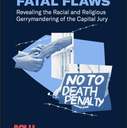Background on Law

On January 12, 2016, in an 8 – 1 decision, the U.S. Supreme Court issued an opinion in Hurst v. Florida, in which the Court struck down as unconstitutional Florida’s capital sentencing statute. At the time of the opinion, Florida death-penalty law required a jury to make a sentencing recommendation – on which only a bare majority of jurors had to agree – to the judge, who would then later “hold a separate hearing and determine whether sufficient aggravating circumstances existed to justify imposing the death penalty.” Under the statute, the jury rendered only an “advisory sentence” of life or death and did not specify the factual basis for its recommendation. Fla. Stat. § 921.141(2). The Court held that the judge-sentencing requirement violated the Sixth Amendment, which guarantees the right to trial by jury, saying: “The Sixth Amendment requires a jury, not a judge, to find each fact necessary to impose a sentence of death. A jury’s mere recommendation is not enough.”
Since then, the Florida legislature has amended its capital sentencing statute three times: first, to comply with its reading of the U.S. Supreme Court’s decision in Hurst, and second, to comply with subsequent Florida Supreme Court cases applying that decision. The third change, in April 2023, rescinded the state’s unanimous-jury requirement. The 2023 law requires only an 8‑juror majority in order for a death sentence to be imposed. The jury must still first unanimously find that an aggravating factor is present. If at least 8 jurors then vote in favor of a death sentence, the judge may impose death. If fewer than 8 jurors vote for death, the judge must impose a life sentence.
The Florida Supreme Court has also issued several key opinions addressing how the law should be interpreted. These decisions will require resentencing for many, but not all, of the prisoners who were unconstitutionally sentenced to death under Florida’s capital sentencing scheme.
(1) CAPITAL SENTENCING STATUTE
In March 2016, the statute was amended to require that jurors unanimously find any aggravating circumstances that the prosecution seeks to prove to make the defendant eligible for the death penalty, and that at least ten jurors recommend death before the judge may consider imposing a death sentence. The amendment repealed a provision of Florida’s death-penalty law that had permitted judges to override a jury’s recommendation of a life sentence.
On October 14, 2016, the Florida Supreme Court decided two cases applying its state constitution and the Sixth Amendment in light of the U.S. Supreme Court’s decision in Hurst to analyze the state’s sentencing practices. On remand from the Supreme Court, the Florida court decided Hurst v. State, holding that the jury was constitutionally required to make several key findings: (1) “the existence of each aggravating factor that has been proven beyond a reasonable doubt”; (2) “the finding that the aggravating factors are sufficient” to justify imposition of a death sentence; and (3) “the finding that the aggravating factors outweigh the mitigating circumstances.” In that case, the Florida Supreme Court also held “that in order for the trial court to impose a sentence of death, the jury’s recommended sentence of death must be unanimous.” In a second case, Perry v. State, the court struck down the Florida legislature’s March 2016 revision of the state’s capital sentencing statute because it did not require a unanimous jury recommendation of death before the trial judge could consider imposing a death sentence.
In March 2017, the Florida legislature amended its capital sentencing law again, this time requiring a unanimous jury determination that the aggravating circumstances are sufficient to justify imposing a death sentence and a unanimous jury recommendation for a death sentence before the judge can impose such a sentence.
In April 2023, the legislature rescinded the unanimous-jury requirement, adopting the nation’s lowest threshold for juries to recommend death sentences by allowing a judge to impose death if at least eight out of twelve jurors agree.
DPIC’s reading of the legislation indicates that, if a jury has not been waived:
- The jury MUST unanimously find, beyond a reasonable doubt, that at least one aggravating factor in the statute exists in the case. Otherwise, the defendant is not eligible for the death penalty.
- If eligible and the jury has at least 8 votes for a death sentence, the recommendation MUST be for death. If there are less than 8 votes for death, the recommendation MUST be for life without parole.
- If the jury’s recommendation is for life without parole, the judge MUST impose that sentence.
- If the jury’s recommendation is for death, the judge MAY impose that sentence or MAY impose a life sentence.
The judge must provide a written order explaining how the sentence was arrived at, including reasons for rejecting a jury’s recommendation, if applicable.
(2) FLORIDA SUPREME COURT DECISIONS REGARDING THE APPLICATION OF HURST TO EXISTING CASES
On June 16, 2016, in Mullens v. State, the Florida Supreme Court held that where the defendant knowingly, voluntarily and intelligently waived his right to jury sentencing, there is no violation under Hurst.
On December 22, 2016, in Mosley v. State, the Florida Supreme Court reiterated that if Hurst applies, relief will only be granted in those cases in which the constitutional violation was not harmless. In order to be harmless, the court said “it must be clear beyond a reasonable doubt that a rational jury would have unanimously found all facts necessary to impose death and that death was the appropriate sentence.” As of June 16, 2017, in all of the cases that have been decided by the Florida Supreme Court in which Hurst applies, the court has found that any unanimous jury recommendation is harmless and that any non-unanimous jury recommendation cannot be harmless.
On December 22, 2016, in Asay v. State, the Florida Supreme Court determined that the rule set forth by the U.S. Supreme Court in Hurst v. Florida—that a jury, not a judge, must find the facts necessary to impose a death sentence — applies to all Florida condemned prisoners whose conviction and sentence became final (i.e., the direct appeal process was completed) after June 24, 2002, the date on which the U.S. Supreme Court decided Ring v. Arizona. Ring held that capital defendants are “entitled to a jury determination of any fact on which the legislature conditions an increase in their maximum punishment” — that is, any facts necessary for the imposition of a death sentence. The Florida Supreme Court reasoned that because the U.S. Supreme Court law prior to Ring had permitted judge sentencing and the state had relied upon that law in good faith, and because the administration of justice would not be served by reversing a large number of death sentences, those whose convictions and death sentences were already final by that date would not be afforded the benefit of the newly pronounced constitutional requirement that a jury must find all facts necessary to impose a death sentence before the court could sentence a defendant to die.
On August 10, 2017, in Hitchcock v. State, the Florida Supreme Court succinctly rejected — without analysis — the seven arguments made by Mr. Hitchcock attacking the constitutionality of his 10 – 2 death sentence that had become final before Ring was decided. Rather than explain its decision, the Court simply held that “[t]hese arguments were rejected when [it] decided Asay [v. State].” Two Justices disagreed with the Court’s reasoning, with Justice Lewis concurring and Justice Pariente dissenting. Justice Lewis would grant relief to prisoners who had raised the issue on appeal in their case, even if it were before Ring was decided, noting that “defendants who properly preserved” the claim “should also be entitled to have their constitutional challenges heard.” Because Hitchcock had not raised the issue on appeal, Justice Lewis agreed with the majority’s result. Justice Pariente dissented in the decision, criticizing the majority for not addressing the issues that were raised by Hitchcock, in particular those related to the Eighth Amendment, which she said were not addressed in Asay. “Reliability is the linchpin of Eighth Amendment jurisprudence,” she wrote, “and a death sentence imposed without a unanimous jury verdict for death is inherently unreliable.” To demonstrate the arbitrariness of the Court’s decision, she quoted an example from Justice Perry: a defendant who committed a crime on an earlier date than another defendant but whose sentence became final after Ring could get relief, whereas the other defendant would be denied relief thereby making “constitutional protection depend on little more than a roll of the dice.”
As a result of the Hitchcock decision, the Florida Supreme Court has precluded an entire class of prisoners from obtaining relief despite having been unconstitutionally sentenced to death. The Florida Supreme Court has at least 75 other cases pending before it that will be affected by Hitchcock. (The brief for Mr. Hitchcock can be read here, and the brief for the state can be read here.) UPDATE: As of February 3, 2018, the Florida Supreme Court has issued 80 opinions in cases denying relief in light of Hitchcock where prisoners had completed the direct appeal process before June 24, 2002 — the day Ring v. Arizona was decided. Of those 80 prisoners, 65 have sentences where the jury vote for death was not unanimous.
UPDATE: As of January 23, 2020, the Florida Supreme Court overruled its precedent and no longer requires unanimity in jury recommendations of death.
DPIC Analysis
To obtain relief under Hurst, prisoners must first petition the court to overturn their sentence. University of Colorado sociology professor Michael Radelet and capital defense lawyer Ben Cohen have published a study estimating that, at the end of 2016, approximately 200 prisoners will be entitled to new sentencing hearings under the Florida Supreme Court’s current application of Hurst. Because of the age of the cases, the fact that one or more jurors have already voted for life, and the expense of retrying capital cases, many are expected to result in life sentences. With the assistance of Hannah Gorman, research scholar and death-penalty clinical instructor at the Florida Center for Capital Representation at Florida International University College of Law, and attorney Melanie Kalmanson of Tracking Florida’s Death Penalty, DPIC has been tracking the death penalty cases decided in Florida since Hurst. DPIC has prepared several charts detailing the extent to which the Hurst-related decisions will affect the nation’s third largest death row, including which death sentences are overturned and the subsequent sentencing disposition of those cases.
Chart: Florida death-row appeals that have been decided in light of Hurst.
Chart: Resentencing status of Florida prisoners sentenced to die by non-unanimous juries.
DPIC and FIU have also been tracking the impact of the Hurst decisions on individual Florida counties. As of July 19, 2018, the three counties* that have produced the largest number of death sentences that have been reviewed thus far in light of Hurst are: Duval (36 sentences); Hillsborough (23 sentences); and Orange (15 sentences). In Duval County, 20 of the 36 (55.56%) death sentences reviewed have been vacated; in Hillsborough County, 8 of the 23 (34.78%) of the death sentences reviewed have been vacated; in Orange County, 9 of the 15 (60.00%) death sentences reviewed have been vacated.
*As of January 1, 2013, each of these counties ranked among the 25 largest county death rows in the United States. Duval ranked 8th, with 60 death-row prisoners; Hillsborough ranked 21st with 25 death-row prisoners; and Orange was tied for 23rd with 23. See DPIC’s 2013 report, The 2% Death Penalty: How a Minority of Counties Produce Most Death Cases At Enormous Costs to All.
Here is the current Florida Death-Row Roster maintained by the Florida Department of Corrections. Per the DOC’s practice, prisoners whose death sentences have been vacated remain on this roster unless and until they have been resentenced to a sentence other than death, die while on death row, or are executed.


